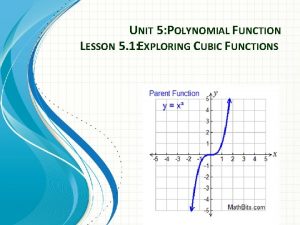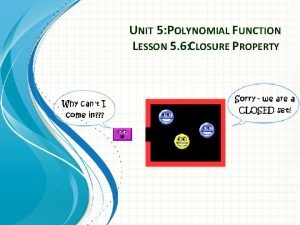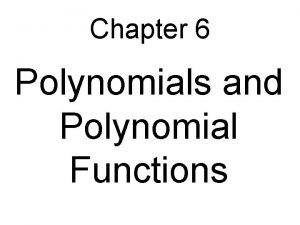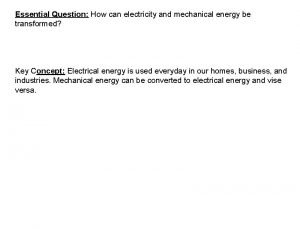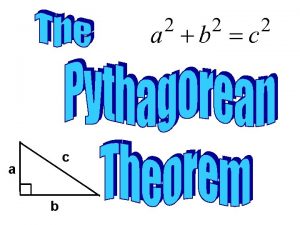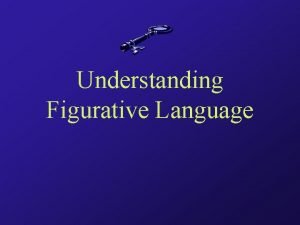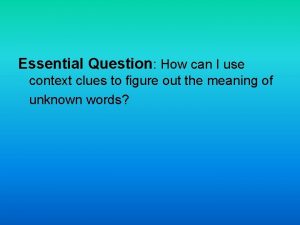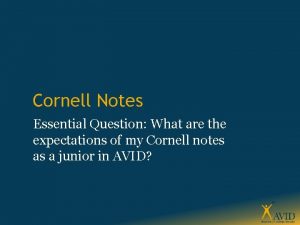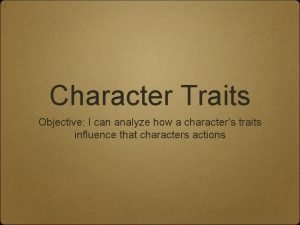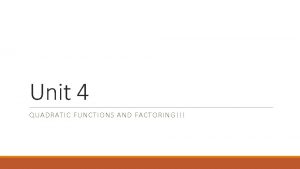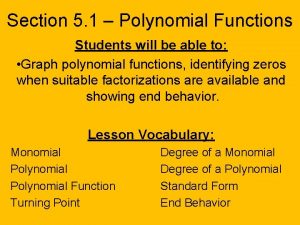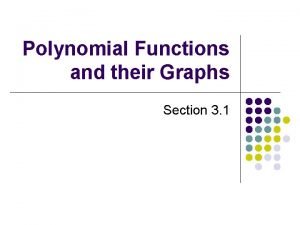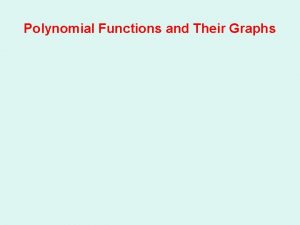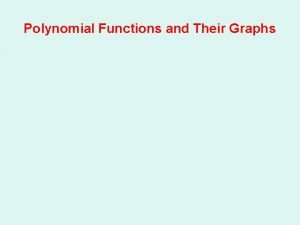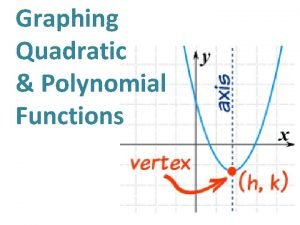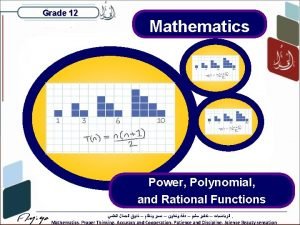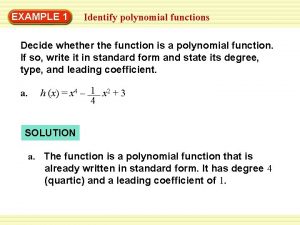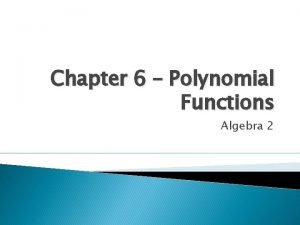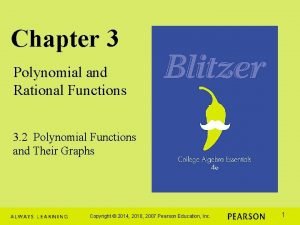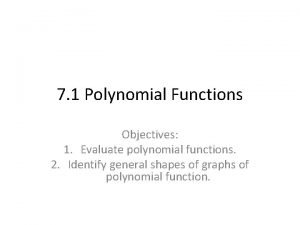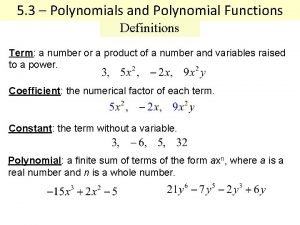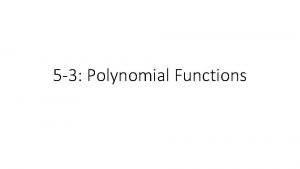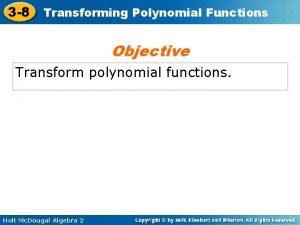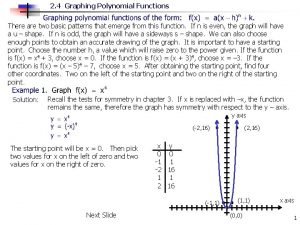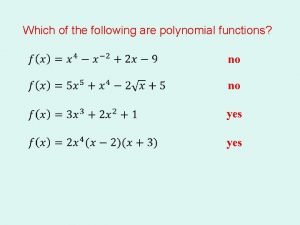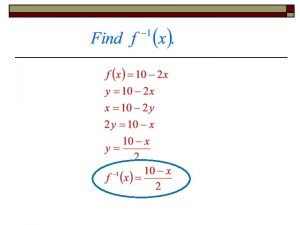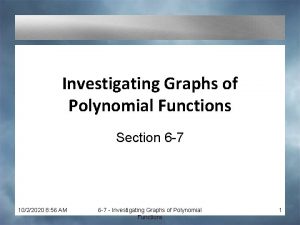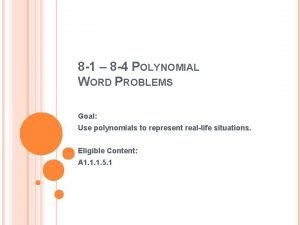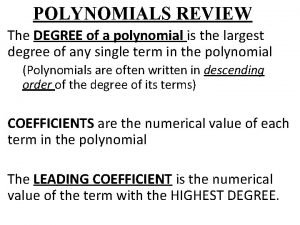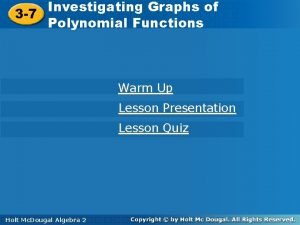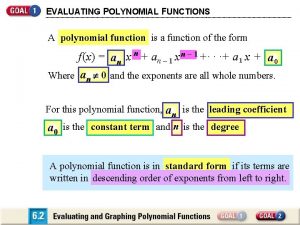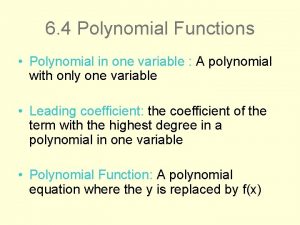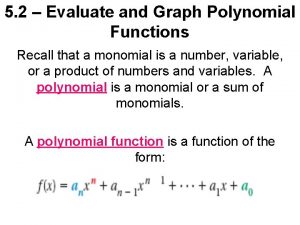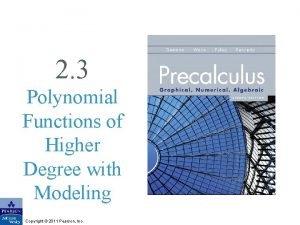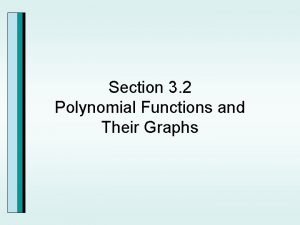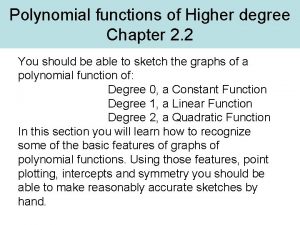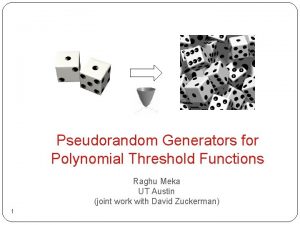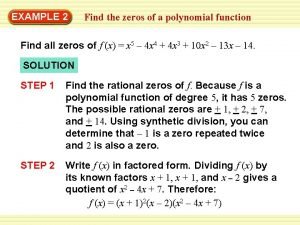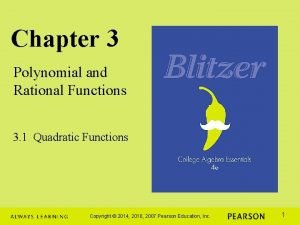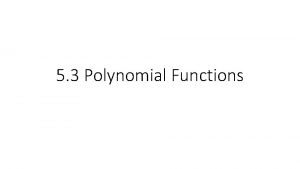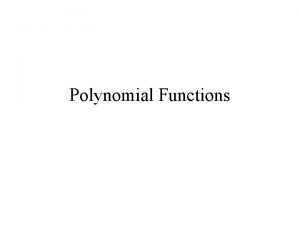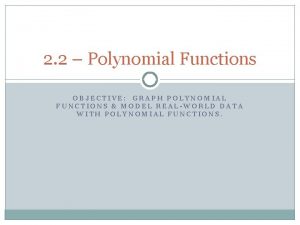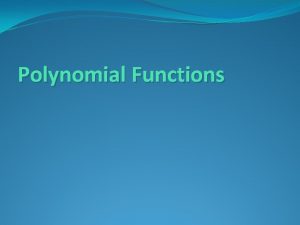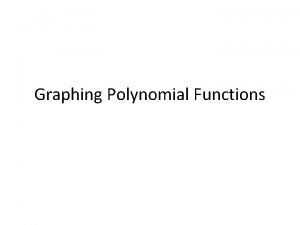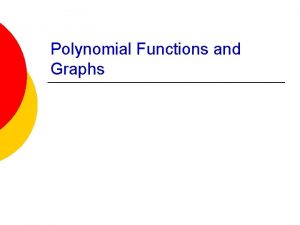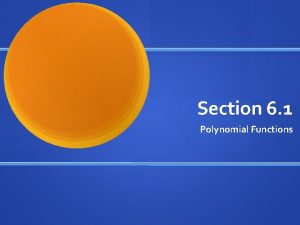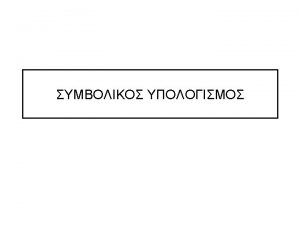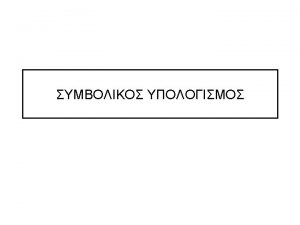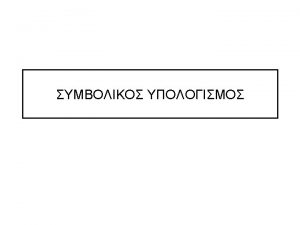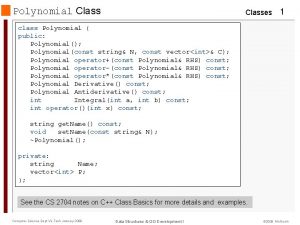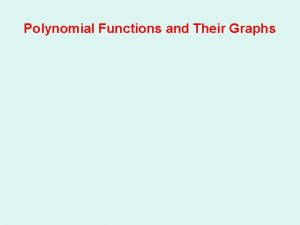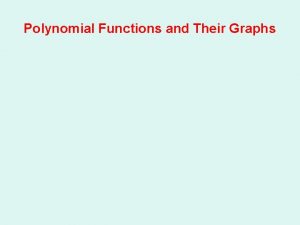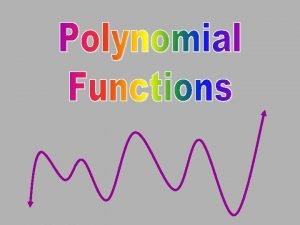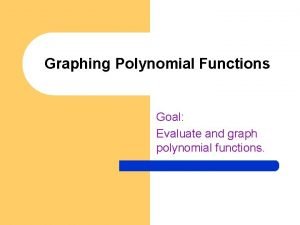Unit 5 POLYNOMIAL FUNCTIONS Unit Essential Question How





































































- Slides: 69

Unit 5 POLYNOMIAL FUNCTIONS

Unit Essential Question: How are the properties of exponents and factoring going to help us solve polynomial functions?

Lesson 5. 1 PROPERTIES OF EXPONENTS

Lesson Essential Question: What are the different properties of exponents and how are they used?

Properties of Exponents: Product of Powers Power of Product Negative Exponent Zero Exponent Quotient of Powers Power of Quotient

Simplifying Expressions using Properties:

Scientific Notation:

Homework: Pages 333 – 334 #’s 3 – 39 odds, 43 – 45

Bell Work:

Classwork/Homework: Page 333 #’s 4 – 42 evens and 46 This assignment is due by the end of class!!!

Bell Work:

Lesson 5. 3 SIMPLIFYING POLYNOMIAL EXPRESSIONS

Lesson Essential Question: How do we simplify polynomial expressions?

Adding and Subtracting Polynomials

Multiplying Polynomials

Homework: Pages 349 - 351 3 – 51 odds and 59 – 62

Bell Work:

Lesson 5. 4 FACTORING AND SOLVING POLYNOMIAL FUNCTIONS

Lesson Essential Question: Why is it necessary to factor a polynomial expression in order to solve the equation?

GCF

Trinomials

Factoring by Grouping

Special Factoring Patterns

Solving Polynomial Equations:

Homework: Pages 356 – 358 #’s 3 – 55 every other odd (3, 7, 11…), then 61 and 62

Bell Work:

Class Work: Pages 356 – 358 #’s 8, 10, 12, 16, 20, 24, 28, 32, 36, 38, 40, 44, 50, 52, 58, 60 This assignment will be collected tomorrow!

Bell Work:

Quiz Tomorrow: Properties of Exponents Scientific Notation Factoring Polynomial Expressions Solving Polynomial Functions

Bell Work:

Bell Work Continued:

Bell Work:

Lesson 5. 5 DIVISION OF POLYNOMIALS

Lesson Essential Question: What are the two ways we can divide polynomials and how do we use the remainder/factor theorem? ? ?

Long Division of Polynomials

Remainders!!!

Homework: Page 366 #’s 3 – 10

Bell Work:

Example:

Synthetic Division:

Remainders!!!

Homework: Page 366 #’s 11 – 18

Bell Work:

Remainder Theorem: When using synthetic division, the remainder that you get when you divide f(x) by some binomial (x – c) is the same value that you would get if you evaluated f(c). This is easier shown by examples.

Factor Theorem: If the remainder you get when you use synthetic or long division is zero, this means that the original divisor you used is an actual factor for the polynomial. Why does this help us? ? ?

This problem is CRAZY GOOD…

Example:

Example:

Homework: Pages 366 - 367 #’s 21 – 39 odds, and two word problems 41 and 42!!! This assignment will be collected!

Bell Work: Be ready to go over last night’s homework!!!

Bell Work:

Lesson 5. 6 FINDING RATIONAL ZEROS

Lesson Essential Question: How do we find all possible rational zeros for a function if it will not factor and we do not know any prior information about the function?

Rational Zero Theorem:

Or… Use your graphing calculator to estimate where a zero might be, then test it using the factor theorem!!!

Examples:

Bell Work:

Homework: Pages 374 - 376 #’s 11 – 17 odds, 25, 29, 33, 45 Find ALL ZEROS for these (this is includes complex and irrational zeros)!!! For 11 – 17 odds, sketch the graph and find the intervals at which f(x) > 0 and f(x) < 0.

Bell Work:

Classwork/Homework: Pages 374 - 375 #’s 12 – 18 evens and 28 – 34 evens 46, and 51 Find ALL ZEROS for these (this is includes complex and irrational zeros)!!! For 12 – 18, find the intervals at which f(x) < 0 and f(x) > 0. This will be collected!!!

Bell Work: Please get out your work from last night and be ready to ask questions.

Pop Quiz:

Test Upcoming!!! Test will be on: Factoring Long Division Synthetic Division Remainder/Factor Theorem Rewriting Polynomials in Factored Form Finding ALL Zeros for a Polynomial Function

Review:

Review:

Review:

Review:

Bell Work: You have been charged with building the base of a statue that will consist of three rectangular blocks. The three blocks have the same height of x, and the base of each block is to be a square. The bottom block will have sides of (8 x + 16), and each block above it will be half of the previous. The volume of the three cement blocks is to be 67, 200 cubic inches. Find the dimensions of each block.

Examples:
 Level 1 2 3 costa level of questioning
Level 1 2 3 costa level of questioning Unit 5: polynomial functions homework 2
Unit 5: polynomial functions homework 2 Unit 5: polynomial functions
Unit 5: polynomial functions Unit 5: polynomial functions
Unit 5: polynomial functions Factoring patterns
Factoring patterns Plamatic acid
Plamatic acid Numpy.polynomial.polynomial
Numpy.polynomial.polynomial How to divide a polynomial by another polynomial
How to divide a polynomial by another polynomial Essential questions about figurative language
Essential questions about figurative language Formula hipotenusa triangle rectangle
Formula hipotenusa triangle rectangle Essential question generator
Essential question generator Essential questions for pythagorean theorem
Essential questions for pythagorean theorem Figurative language essential questions
Figurative language essential questions Individual vs society
Individual vs society Use context clues in figuring out the meaning
Use context clues in figuring out the meaning What is the essential question in cornell notes
What is the essential question in cornell notes What if questions to ask
What if questions to ask Essential question for multiplication
Essential question for multiplication Essential question gif
Essential question gif Internal and external character traits
Internal and external character traits What is the cornell way
What is the cornell way Essential questions for short stories
Essential questions for short stories Core functions and essential services of public health
Core functions and essential services of public health Core functions and essential services of public health
Core functions and essential services of public health Unit 4 test solving quadratic equations and complex numbers
Unit 4 test solving quadratic equations and complex numbers 6 essential nutrients and their functions
6 essential nutrients and their functions 5-1 polynomial functions
5-1 polynomial functions Different types of polynomial
Different types of polynomial End behavior how to find
End behavior how to find Leading coefficient
Leading coefficient Practice a investigating graphs of polynomial functions
Practice a investigating graphs of polynomial functions Investigating graphs of polynomial functions
Investigating graphs of polynomial functions Polynomial end behavior chart
Polynomial end behavior chart Quadratic polynomial function
Quadratic polynomial function Polynomial functions grade 12
Polynomial functions grade 12 Decide whether the function is a polynomial function
Decide whether the function is a polynomial function Practice 6-2 polynomials and linear factors
Practice 6-2 polynomials and linear factors Chapter 4 polynomial and rational functions
Chapter 4 polynomial and rational functions Chapter 3 polynomial and rational functions
Chapter 3 polynomial and rational functions Evaluating polynomial functions
Evaluating polynomial functions Transformation of polynomial functions
Transformation of polynomial functions 5-3 skills practice polynomial functions
5-3 skills practice polynomial functions Odd degree polynomial
Odd degree polynomial Transformation of polynomial functions
Transformation of polynomial functions (-2 4) graph
(-2 4) graph Sign of the functions leading coefficient
Sign of the functions leading coefficient Example of polynomial in real life
Example of polynomial in real life Polynomial functions of higher degree
Polynomial functions of higher degree 6-7 investigating graphs of polynomial functions
6-7 investigating graphs of polynomial functions Polynomial word problem examples
Polynomial word problem examples 5-4 analyzing graphs of polynomial functions
5-4 analyzing graphs of polynomial functions Deegree symbol
Deegree symbol Analyzing graphs of polynomial functions calculator
Analyzing graphs of polynomial functions calculator Degree 5 graph
Degree 5 graph Investigating graphs of polynomial functions
Investigating graphs of polynomial functions Evaluating polynomial functions
Evaluating polynomial functions Polynomial functions in one variable
Polynomial functions in one variable Evaluate and graph polynomial functions
Evaluate and graph polynomial functions Polynomial functions of higher degree with modeling
Polynomial functions of higher degree with modeling Polynomial functions and their graphs
Polynomial functions and their graphs Polynomial
Polynomial Power function
Power function Lesson 5-2 graphing polynomial functions answers
Lesson 5-2 graphing polynomial functions answers Polynomial threshold functions
Polynomial threshold functions Zero polynomial
Zero polynomial Chapter 3 polynomial and rational functions
Chapter 3 polynomial and rational functions 5-1 polynomial functions
5-1 polynomial functions Question without question words
Question without question words Advantages and disadvantages of probing questions
Advantages and disadvantages of probing questions Contoh open question
Contoh open question


